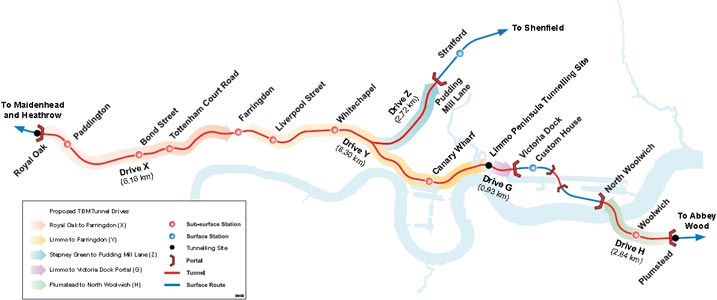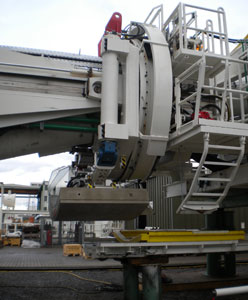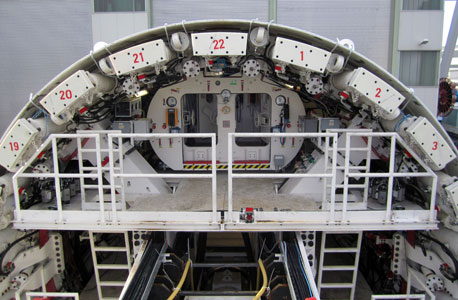TBM RECORDER
Herrenknecht begins roll out of Crossrail orders
Dec 2011
- Of the 15 bays that can be building TBMs simultaneously at the Herrenknecht factory in Schwanau, two are currently occupied by the first of eight TBMs for the Crossrail project in London. Both are factory assembled and commissioned and components of the first will be stripped and shipped before the end of the year in preparation for meeting the significant milestone of having TBM tunnelling started on the multi-billion pound project by March 2012.
-

First Crossrail EPBM ready for dispatch
- All eight TBMs needed to excavate nearly 50km of tunnelling for the project are on order with Herrenknecht. Six EPBMs of 7.1m diameter will excavate 21km of twin tube 6.2m i.d. segmentally lined running tunnels in eight drives beneath the streets of London from Royal Oak Portal near Paddington in the west to Pudding Mill Lane Portal near Stratford in the northeast and Victoria Dock Portal on the Abbey Wood spur in the southeast. Two slurry Mixshield machines will complete the parallel 2.6km tunnels under the Thames from North Woolwich to Plumstead Portal (Fig 1).
- The first two machines ready for dispatch are on order for the BFK (Bam/Ferrovial/Kier) JV in preparation for excavation of the 6.4km twin tunnels from Royal Oak to Farringdon. From the Tilbury Docks in east London, the machine components will be transported to Westbourne Park for launch at the completed Royal Oak portals. Once launched in March and April 2012, the machines will operate 24h/day, 7 days/wk to produce an average advance of 100m/wk through an almost uniform deposit of London Clay. En route, both machines will mine through the Bond Street and Tottenham Court Road Station zones for later breakout of the concrete segment lining for Contract 410 SCL excavation of station concourse and platform caverns. Excavated also by the BFK JV, muck from the station cavern excavations will be transported back through the tunnels to the Royal Oak portal for onward final disposal.
-

Fig 1. Ten Crossrail drives for eight Herrenknecht TBMs
- The next four EPBMs are on order for the Dragados/J Sisk & Son JV, for six drives. The first two machines will start in mid-2012 for the 8.3km drives from the working site at Limmo Peninsula in the Royal Docks to Farringdon; the second two to start later in 2012 for the 2.7km drives from Pudding Mill Lane to an underground junction chamber with the first drives at Stepney Green. The first two machines will then return to the Limmo Peninsula working site for the last two 900m drives east to the Victoria Dock Portal. These four TBMs will also work mostly through London Clay but will dip into the the waterbearing sands and gravels of the Woolwich and Reading Beds and Thanet Sands at the east end.
-

Royal Oak Portal completed early in Sept 2011 and awaiting launch of the first two EPBMs
- The final two Herrenknecht TBMs are slurry machines for the Hochtief/J Murphy JV. The machines will be delivered and will launch from the Plumstead Portal south of the river in 2013 and will drive under the Thames to the North Woolwich Portal. The drives are mostly through chalk in which hard abrasive flints are anticipated.
-
Tight TBM specifications
At a Crossrail arranged visit to view the first two TBMs at the Herrenknecht factory in Schwanau on Monday this week (12 December), the invited trade press and general media journalists heard how design of the machines is a collaboration between the technical advisers for Crossrail, led by Gordon Ince, engineers from the TBM-operating construction JVs, and design engineers with Herrenknecht. - "The letter of intent for these first two machines was signed in April and the order confirmed in July," said Herrenknecht's UK Director Roy Slocombe. "The first machines are therefore ready for dispatch within 10 months. The remaining six machines will follow on during 2012."
- The machines are described as having a high technical specification. The 7.1m o.d. EPBMs have a main drive power of 1,920kW, maximum torque of 9,800kNm, a cutterhead rotation of 0-3.19rev/min; and a nominal thrust force of about 58,000kN. The 15m long x 900mm diameter screw conveyor will discharge onto a continuous muck-haulage conveyor to the surface for onward disposal.
- These first two EPBMs for the Western Tunnels contract are expected to operate at a maximum 3 bar pressure. A twin-cell airlock on the upper part of the bulkhead, with external doors on both and an inner connecting door between them, allows for two-way traffic through the lock, one lock decompressing while the other is going under pressure. This provides flexibility, saves time, and improves safety in and out of the hyperbaric environment.
- Control to avoid over-excavation and surface settlement has been a high priority for the drives under the heart of London.
-

Shield ports for forward drilling and lateral shield-annulus backfilling
- Andy Alder, Crossrail Project Manager, who was with the press visit day, explained: "The machines are required to operate in the closed mode at all times. Generation and injection of conditioning agents will be a crucial part of the operation as will injection of void-filling material around the shield. PLC controlled injection of the two-part annular grout will be injected through the three-row wire brush tail seal. We have also insisted on two weigh stations on the conveyor belt to monitor closely the volume of material extraction. Over excavation cannot be tolerated on these city centre drives."
- Chris Dulake, Crossrail Chief Engineer, explained the choice of continuous conveyor muck haulage over trains of muck skips. "Both methods were permitted but very tight controls were imposed on rail-bound equipment to control and limit vibration of rolling stock during construction. This is to protect the offices and other sensitive infrastructure above and around the Crossrail alignment corridor, which includes historic listed buildings, other tunnelled infrastructure including old brick built sewers, and the Barbican concert hall in the City. These favoured the use of the continuous conveyor systems over trains of muck skips."
-

Continuous conveyors limit rolling stock to lighter service trains
- Among other features included on the Herrenknecht machines are ports around the shield cans for drilling and injection if ever needed ahead of the cutterhead and tunnel face, and devices on the cutterhead to monitor wear of cutterhead tools.
- This will be more critical on the two slurry Mixshields working on the Thames Tunnel through flint-infested chalk, and the EPBMs that will dip into the Woolwich and Reading Beds and Thanet Sands on the Eastern Tunnel drives. The points will be filled with high-pressure oil protected by wear gauges bursting should wear become excessive.
- Transport of the first two of eight Crossrail machines from the Herrenknecht factory is an important milestone and reminds us that this mega-project for London is finally taking shape after decades of delay and postponement. Progress also raises hopes for follow-on tunnelling projects such as Crossrail 2 – a proposed north-south addition between Chelsea and Hackney, and High Speed Rail 2 – north from London to Birmingham, and eventually to Scotland.
-
Crossrail's programme for assuring value - TunnelTalk, July 2011
All Crossrail TBMs in the Herrenknecht basket - TunnelTalk, Sept 2011
Crossrail awards central station contracts - TunnelTalk, Nov 2011
UK rail from the Channel Tunnel and beyond - TunnelTalk, Dec 2010
UK reconsiders High-Speed 2 tunnel alignment - TunnelTalk, Dec 2011
|
|
|
|
|
Add your comment
- Thank you for taking the time to share your thoughts and comments. You share in the wider tunnelling community, so please keep your comments smart and civil. Don't attack other readers personally, and keep your language professional.



